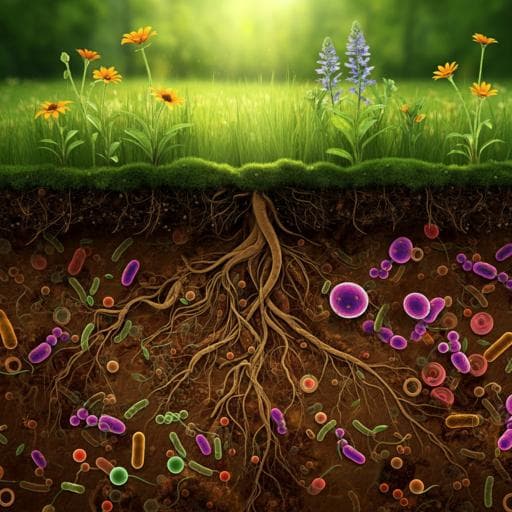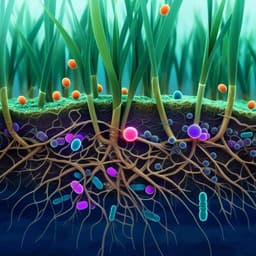
Environmental Studies and Forestry
Rapid differentiation of soil and root microbiomes in response to plant composition and biodiversity in the field
H. M. Burrill, G. Wang, et al.
Discover how soil and root microbiomes quickly adapt to changes in plant diversity and composition, revealing insights into microbial community dynamics. This cutting-edge research was conducted by Haley M. Burrill, Guangzhou Wang, and James D. Bever.
~3 min • Beginner • English
Introduction
The study investigates how quickly and how strongly different components of plant-associated microbiomes (pathogens, mutualists such as AMF, saprotrophs, and bacteria) differentiate in response to plant community composition, phylogenetic relatedness, and species richness under field conditions. Background theory suggests plant–microbiome feedbacks can mediate plant coexistence, with negative feedbacks often driven by host-specific pathogens at low diversity and positive feedbacks via mutualists potentially generating alternative stable states. Prior greenhouse work indicates that pathogen and AMF differentiation can occur within a growing season, but field evidence on rates and relative strength across microbial groups is limited. The authors hypothesized that (1) host-specific pathogens (fungal pathogens and oomycetes) would differentiate more strongly and rapidly than other groups; (2) root-associated communities would show stronger and faster differentiation than bulk soil; and (3) groups with stronger host specialization would respond more to plant species richness. They also expected phylogenetic relatedness of host plants (within-family vs multi-family mixtures) to structure microbiome differentiation and potentially modulate diversity–productivity relationships via pathogen dilution or mutualist-mediated effects.
Literature Review
The paper situates the work within plant–soil feedback (PSF) theory, citing evidence that host-specific pathogens can promote coexistence through negative feedback and that mutualists (AMF, rhizobia) can generate positive feedbacks. Greenhouse studies show pathogen-driven negative feedbacks and AMF host-specific differentiation can arise within one season. Field studies have documented spatial variation in microbiome components near mature plants but few manipulations assess short-term differentiation across multiple microbial groups. Phylogenetic distance among hosts is linked to stronger negative PSF and pathogen specialization; phylogenetic signals also occur in AMF impacts and saprotroph composition. Plant community richness can dampen host-specific pathogen accumulation (dilution effect) and shift mycorrhizal composition, potentially contributing to diversity–productivity relationships. Root proximity imposes host filters via exudates and immune responses, suggesting faster and stronger root vs soil differentiation, especially for pathogens and AMF; fewer studies compare root and soil compartments directly.
Methodology
Study site: Tallgrass prairie region at the KU Field Station, Lawrence, KS, USA (39.052462, -95.191656). The site is post-agricultural; resident soils were tilled and amended with an average 3.8 cm of soil from an unplowed prairie remnant near Welda, KS (38.179600, -95.265695) to provide native microbial inoculum.
Experimental design: Established June 2018. Eighteen native prairie species (6 each from Poaceae, Fabaceae, Asteraceae) were used to assemble 240 plots (1.5 m × 1.5 m) spanning plant species richness (1, 2, 3, 6 species), phylogenetic dispersion (under-dispersed: single family; over-dispersed: multi-family), and a future precipitation manipulation (50% vs 150% of ambient; not applied before sampling used here). The 240 plots represent two replicates of 120 unique plant combinations; for this analysis, matched replicate plots (paired by future rainfall treatment) were pooled, yielding 120 samples: 36 monocultures, 36 two-species, 24 three-species, and 24 six-species plots. Phylogenetic dispersion categories analyzed: multi-family, under-dispersed Poaceae, under-dispersed Fabaceae, under-dispersed Asteraceae. Seeding: each plot received 100 seeds per species (total 1,800 seeds/plot), mixed evenly by weight. Transplants: 18 seedlings per plot were greenhouse-grown in sterile potting soil with 98 mL Welda soil inoculum and planted in May 2018 in a hexagonal grid. One weeding round occurred before sampling (forbs removed; grasses <3 inches retained).
Sampling and DNA extraction: In September 2018 (≈4 months after planting), two 20 cm soil cores per plot were collected; for each matched pair of replicate plots, soils were pooled, chilled, and frozen at −20 °C within 5 hours. Samples were homogenized, roots sieved out, and DNA was extracted separately from 0.25 g soil and 0.25 g roots (Qiagen DNeasy PowerSoil kit).
Amplicon library preparation and sequencing: Two-step PCR with community-specific primers followed by AMPure XP clean-ups and Nextera XT v2 barcoding. Illumina MiSeq v3 PE300 sequencing at KU Genome Sequencing Core. Communities and primers: fungi ITS2 (FITS7/ITS4), AMF LSU (fLR0R/FLR2), bacteria 16S rRNA V4 (515F/806R), oomycetes ITS (ITS300/ITS4; HOT FIREPol chemistry). Thermocycling conditions followed primer-specific protocols. PCR products were quality-checked by gel and quantified by Qubit.
Bioinformatics: QIIME2 pipeline with DADA2 for quality filtering, trimming, denoising, merging, and chimera removal. Singletons/very rare OTUs (≤5 occurrences across all samples) were removed. Taxonomy: SILVA 99% (bacteria) and UNITE 99% (fungi). Functional guilds for fungi assigned via FUNGuild; putative pathogens: trophic mode Pathotroph, guild plant pathogen; saprotrophs: guilds including Saprotroph but excluding Pathotroph; only “probable” or “highly probable” guilds retained. AMF LSU reads filtered using a curated AMF phylogeny (Mortierella elongata outgroup) to retain AMF; oomycete OTUs validated by BLAST against NCBI oomycete ITS2 or by phylogenetic placement in Oomycota. Resulting OTU counts: bacteria (roots 2,022; soil 1,261), fungi (soil 7,272 OTUs of which 1,904 guild-assigned; roots 3,650 of which 964 guild-assigned), AMF (roots 2,395; soil 8,230), oomycetes (roots 141; soil 460).
Network analysis: Constructed Spearman correlation networks (|r|>0.7, p<0.001; Benjamini–Hochberg correction) across OTUs within and between groups for roots and soil; visualization with igraph/Gephi; interaction proportions summarized (Fig. 2).
Diversity and composition analyses: Shannon diversity (H′) computed (vegan) with rarefaction diagnostics (adiv). General linear models tested effects of block, planted species richness (PIntDiv), phylogenetic dispersion (PhyloFam), planted proportions of each of the 18 species, and the PIntDiv×PhyloFam interaction on H′ for each group and compartment. For composition, OTU tables were centered log-ratio transformed; Bray–Curtis dissimilarity used in PERMANOVA (vegan) with the same model. Beta dispersion tested via betadisper for significant terms. Principal coordinate analyses (ecodist pco) examined which axes contributed to significant PERMANOVA terms. To assess plant family effects on putative pathogen composition, relative abundances of pathogen OTUs at genus level were computed (usearch10) and tested by GLMs. Sequencing data are deposited at NCBI SRA, BioProject PRJNA863284.
Key Findings
- Rapid response across groups: All microbial groups (fungi, fungal saprotrophs, putative fungal pathogens, bacteria, AMF, oomycetes) showed responses to planting design within 4 months, in either soil, roots, or both.
- Root–soil compartment contrasts: Co-occurrence analyses indicated significant correlation between root and soil communities only for bacteria; other groups were largely decoupled between compartments.
- Diversity responses to plant richness:
• Soil: Fungal pathogen diversity increased with richness (PIntDiv F=4.89, p=0.029). Oomycete diversity decreased with richness (F=6.22, p=0.014). Bacteria and AMF diversity showed no significant richness responses.
• Roots: Fungal saprotroph diversity increased with richness (p=0.01). Fungal pathogen diversity increased (p=0.05). Oomycete diversity marginally increased (p=0.07). AMF diversity marginally increased (p=0.09). Root bacterial diversity decreased with richness (p=0.05).
- Composition responses (PERMANOVA):
• Soil fungal pathogens were differentiated by plant species richness (R2=0.014, p=0.031) and by planted proportions of specific species (e.g., Chamaecrista fasciculata p=0.01; Schizachyrium scoparium p=0.082; Coreopsis tinctoria p=0.06).
• Root bacteria composition strongly differentiated by plant family composition (PhyloFam R2=0.103, p=0.001), with additional effects of specific species across families (Fabaceae: Amorpha canescens p=0.002, Desmodium canadense p=0.034, Dalea purpurea p=0.001; Poaceae: Panicum virgatum p=0.005; Asteraceae: Liatris pycnostachya p=0.008, Coreopsis tinctoria p=0.006, Silphium integrifolium p=0.005, Heliopsis mollis p=0.025). Interaction of richness × family was significant/marginal in soil and roots for bacteria and saprotrophs (e.g., root bacteria PIntDiv×PhyloFam R2=0.027, p=0.065; soil bacteria R2=0.030, p=0.016; root saprotrophs R2=0.032, p=0.028).
• Root fungal saprotroph composition responded to specific species (Helianthus mollis p=0.048; Desmodium canadense p=0.033) and to richness × family interaction (p=0.028), with marginal richness effect (p=0.085).
• Root oomycetes showed a marginal response to plant family composition (R2=0.034, p=0.061).
• Root AMF composition responded to planted proportions of specific hosts (Schizachyrium scoparium p=0.02; Amorpha canescens p=0.028; Desmanthus illinoensis p=0.05) but not to family or richness overall.
- Beta dispersion: Differences among plant family treatments were significant for root bacteria (F=3.397, p=0.02) and among richness treatments for root saprotrophs (F=2.726, p=0.04); not significant for soil fungal pathogen response to richness nor for root oomycete response to family.
- Axes driving divergence (PCoA): Soil fungal pathogens differentiated by family on PC1 (p=0.04) and PC5 (p=0.001). Root non-pathogenic fungi showed family effects on PC1 (p=0.01). Root oomycetes showed effects on PC6 (p=0.02). Root bacteria showed very strong family effects on PC1 and PC2 (p≪0.001).
- Taxon-specific pathogen patterns: Soil pathogen genera Monographella, Cercospora, and Erysiphe were more abundant in Fabaceae-only plots; Stagonospora was most abundant in Poaceae plots, indicating pathogen specialization consistent with plant family.
- Overall: Root bacteria and soil fungal pathogens exhibited the strongest and most rapid differentiation with plant composition; AMF responses were weaker and more host-species specific than family- or richness-wide within the 4-month timeframe. Evidence suggests decomposer home-field advantage in saprotrophs and potential implications for diversity–productivity via pathogen dilution and mutualist dynamics.
Discussion
The findings support the hypotheses of rapid and host-structured microbiome differentiation in field conditions within four months of establishment. Strong differentiation in root bacteria by plant family and in soil fungal pathogens by plant composition suggests these groups are prime candidates for driving early plant–soil feedbacks, with potential consequences for plant coexistence and community assembly. The phylogenetic signal observed—pathogen genera aligning with plant family compositions—aligns with theory predicting stronger negative feedbacks among phylogenetically distant hosts due to specialized pathogen pressures. Diversity responses indicate potential for both dilution of specialist pathogens (soil oomycetes decreasing with richness) and increased detection of diverse specialist pathogen assemblages at higher richness (fungal pathogens increasing with richness), underscoring complex richness–pathogen dynamics. Root vs soil contrasts show stronger host filtering in roots for bacteria and non-pathogenic fungi, while pathogen signals were more pronounced in soil, consistent with pathogen release from rapidly turned-over infected roots and soil-mediated transmission. Saprotroph and bacterial compositional shifts with plant family, especially at higher richness levels, suggest decomposer communities track litter/plant traits, consistent with home-field advantage mechanisms. Collectively, these results indicate that microbial community changes can act swiftly to modulate plant growth and interactions, potentially mediating diversity–productivity relationships through pathogen dilution and mutualist availability. The weaker, host-specific AMF signals imply mutualist-driven feedbacks may develop more slowly than pathogen-driven effects in early stages post-establishment.
Conclusion
Within four months of establishing diverse prairie plantings, microbiomes in both soil and roots differentiated in response to plant species richness, phylogenetic composition, and individual host species. The strongest responses were observed in root bacteria (family-driven) and soil fungal pathogens (richness and composition-driven), with additional evidence for decomposer home-field advantage in saprotrophs. AMF responses were detectable mainly at the level of particular host species, suggesting slower or more host-specific changes relative to pathogens and bacteria in early stages. These rapid microbial shifts are consistent with mechanisms of plant–soil feedback that can influence plant community structure and ecosystem processes, highlighting the value of native microbial inoculation in restoration. Future work should explicitly link microbial differentiation to plant performance, coexistence dynamics, decomposition rates, and temporal trajectories of diversity–productivity relationships, while integrating forthcoming precipitation treatments and functional assays.
Limitations
- Temporal scope: Sampling occurred only four months after planting; longer-term dynamics may alter patterns, particularly for AMF and saprotrophs.
- Functional inference limits: Many bacterial taxa could not be assigned to functional roles; conclusions about decomposer vs mutualist/pathogen roles in bacteria are tentative.
- Environmental DNA artifacts: Potential influence of relic (inactive) DNA in soil could dilute or obscure soil community responses.
- Experimental pooling: Samples from replicated plots across future precipitation treatments were pooled prior to analysis, precluding assessment of within-combination variability and precipitation effects at this stage.
- Taxonomic resolution and guild assignment: FUNGuild assignments for fungi rely on existing databases and confidence thresholds; oomycetes were assumed primarily plant pathogenic based on general ecology, which may not hold for all taxa.
- No direct functional measurements: Decomposition rates and plant performance/productivity metrics concurrent with microbiome sampling were not included here, limiting direct linkage to ecosystem function.
- Site and community scope: Results are from a single region and set of prairie species; generalizability to other ecosystems and plant lineages may be limited.
Related Publications
Explore these studies to deepen your understanding of the subject.







